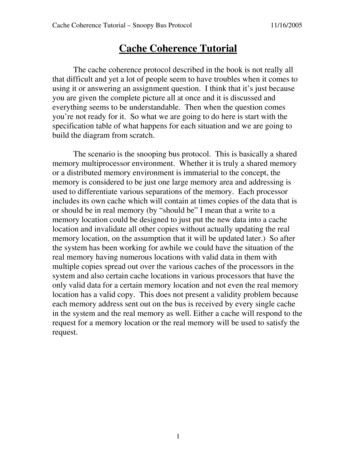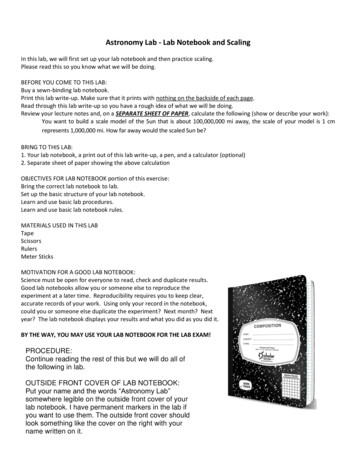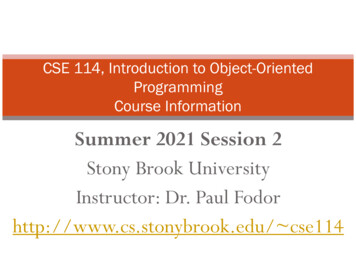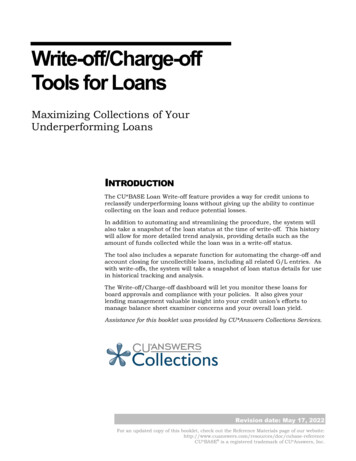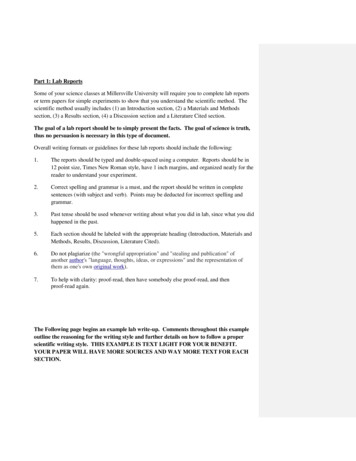
Transcription
Part 1: Lab ReportsSome of your science classes at Millersville University will require you to complete lab reportsor term papers for simple experiments to show that you understand the scientific method. Thescientific method usually includes (1) an Introduction section, (2) a Materials and Methodssection, (3) a Results section, (4) a Discussion section and a Literature Cited section.The goal of a lab report should be to simply present the facts. The goal of science is truth,thus no persuasion is necessary in this type of document.Overall writing formats or guidelines for these lab reports should include the following:1.The reports should be typed and double-spaced using a computer. Reports should be in12 point size, Times New Roman style, have 1 inch margins, and organized neatly for thereader to understand your experiment.2.Correct spelling and grammar is a must, and the report should be written in completesentences (with subject and verb). Points may be deducted for incorrect spelling andgrammar.3.Past tense should be used whenever writing about what you did in lab, since what you didhappened in the past.5.Each section should be labeled with the appropriate heading (Introduction, Materials andMethods, Results, Discussion, Literature Cited).6.Do not plagiarize (the "wrongful appropriation" and "stealing and publication" ofanother author's "language, thoughts, ideas, or expressions" and the representation ofthem as one's own original work).7.To help with clarity: proof-read, then have somebody else proof-read, and thenproof-read again.The Following page begins an example lab write-up. Comments throughout this exampleoutline the reasoning for the writing style and further details on how to follow a properscientific writing style. THIS EXAMPLE IS TEXT LIGHT FOR YOUR BENEFIT.YOUR PAPER WILL HAVE MORE SOURCES AND WAY MORE TEXT FOR EACHSECTION.
John SmithPrinciples of Zoology/Section BLab Report #3Comment [ah1]: Student name, class, lab #,and date should be at upper left and single-spaced.IMPACTS OF NITROGEN ON PLANT GROWTHJOHN SMITH, Millersville University, Millersville, PA, 17551.Comment [AH2]: Student name and schooladdress.Abstract: We wanted to evaluate the effect of nitrogen fertilizer on American water weedComment [AH3]: Term paper or lab reportsshould include an abstract page after the titlepage. An abstract is a paragraph that summarizesthe whole paper (all sections). I wouldrecommend writing the full paper and then writingthe abstract last. This will make things easier.(Elodea Canadensis) biomass growth. Our hypothesis was that more nitrogen fertilizer wouldincrease plant biomass. We used 5 cultured bowls in which to grow plants. Each cultured bowlcontained an increasing amount of nitrogen fertilizer, starting with bowl 1 with the least amountwith increasing to bowl 5. We conducted 2 separate experiments to evaluate consistency ofresults. We found that plant biomass growth increased with more nitrogen fertilizer to a point.At the highest levels of nitrogen, plant growth declined dramatically. Both experiments had theDeveloping a complete and solid abstract is veryimportant. Many times you will be submittingthis abstract of your research to scientificsymposiums and conferences so that you can gainapproval to present your research at these venues.Comment [AH4]: Your abstract only needs tobe one paragraph. It should include the goals ofthe paper, main points you found, results and anydiscussion of these main points to yourhypothesis, future research needs or finalconclusions.Citations are not in the abstract.same conclusion with results having no significant difference (P 0.05). We suggest furtherresearch into the potential toxic impacts of too much nitrogen fertilizer on plant growth.IntroductionThe purpose of this lab was to examine the effect of nitrogen fertilization on plantgrowth. Nitrogen occurs in all living organisms and is believed to be an important nutrient forplant growth (Chalk 1991). To evaluate the impacts of nitrogen on plant growth, the aquaticplant American water weed (Elodea canadensis) was grown in water containing differentComment [ah5]: In the Introduction you startout describing a question about what your researchis going to answer. Then you give backgroundliterature on all the other studies that have tried toanswer this question or tried to answer questionssimilar to the one you are doing research on. Thenyou briefly state the objectives of your experimentsand the type of experiments you performed.Towards the end of your Introduction you specifythe goal of your experiments and state a hypothesisof what you expect to happen during theexperiment.Your introduction will be much longer.amounts of nitrogen. Ammonium nitrate was used as our source of nitrogen fertilizer.The hypothesis tested was that since American water weed requires nitrogen to makeorganic compounds like proteins (Chalk 1991), the more nitrogen it has available, the better itshould grow. The null hypothesis was that nitrogen would have no impact on plant growth.Comment [AH6]: Citation style from sourcethat had 1 author.Comment [ah7]: For every organismmentioned you should include its scientific namewhen it is first mentioned. This includes thegenus name that is capitalized and the speciesname in lower case. The scientific name is initalics and in parenthesis.Comment [ah8]: Lab is written in past tense.This lab is on work that you have alreadycompleted.
Materials and MethodsFive glass cultures bowls were filled with one liter of distilled water. Each bowl wasgiven a different amount of ammonium nitrate as displayed in Table 1.Comment [ah9]: Provide a discussion, in yourwords, of the procedures you performed and all thematerials you used during the course of yourexperiments. The Materials and Methods sectionshould be written with clarity so another individualcould successfully replicate this experiment basedon your description. This section is written as anarrative, NOT a bullet list of things you did.Your Methods and Material will be much longer.Table 1. Grams of ammonium nitrate added to each culture bowl to evaluate the impacts ofnitrate on plant growth.Bowl no.1Ammonium nitrate (g)0 g (negative control)20.1 g31g410 g5100 gFive sprigs of American water weed, with a mass of about 0.4 g , was placed into eachculture bowl. The culture bowls were placed in a growth chamber set to a12 hr light period perComment [ah10]: Again the use of past tense.Comment [ah11]: All tables need to bereferenced in the text before they appear in thereport.Comment [ah12]: Every table should belabeled and numbered based on when it isreferenced in the text. The data in this table wasreferenced first, thus this is Table 1.Comment [ah13]: Each Table should have acaption consisting of a sentence or two describingthe data in the Table. The goal of producing atable is to be able to have it stand alone sosomeone could read the table without reading thetext and still understand the data being recorded.Captions for Tables are located on top of thetable. Data in the table is centered, except for thefirst column which provides labels for each row.Tables should not have vertical lines, thus DONOT cut and paste from EXCEL.Comment [ah14]: No vertical lines should bein the tables. Vertical lines make the data harderto see and make the table look incomplete. Alldata should be centered except for the firstcolumn.Comment [ah15]: All numbers need to bewritten out when beginning a sentence.day and an average temperature of 28 C for three weeks. Water was added during the course ofComment [AH16]: Note that this sample sizeis too small. Again, this is a shortened lab reportfor guidance purposes.the experiment to keep the solution level at one liter in each bowl, but no additional ammoniumComment [AH17]: All numbers should have adigit in front of a decimal if there is a decimal.nitrate was added. At the end of the three-week period, the mean final mass of each AmericanComment [AH18]: Make sure all yournumbers have the correct units indicated.water weed plant from each culture bowl was recorded and then compared for analysis. Thissame procedure was run again for 5 more bowls to test for experiment consistency.We used a student t-test assuming equal variance to compare the means between the 2experiments using the EXCEL program. Statistical significance was based on a p-value 0.05.Comment [AH19]: The end of the materialsand methods section should describe thequantitative analysis that was conducted. This iswhat statistical test you used to analyze data.
ResultsWe wanted to test to see if the amount of nitrogen fertilizer impacts plant biomassgrowth. Plants with higher levels of nitrogen had greater plant mass except for bowl number 5(Figure 1). We found the same results for both experiments, where the mean of experiment 1 wasComment [ah20]: Your results should have textwhich directly and concisely tells you the results ofthe experiment. The results of your experimentscan often be displayed in the form of tables orfigures (graphs or pictures). It is customary tonumber and label each table and figure, and thenrefer to each table and figure, in order, in the text ofyour report.Your results section will be longer.2.23 and mean of experiment was 2.10 (Figure 2). The t-statistic value was 0.25 and was lessthan the t-critical value of 2.31, also the p-value was 0.81 which is greater than 0.05 (Table 2),thus we found no significant difference in plant mass between experiments 1 and 2. TheAmerican water weed plant in bowl 5 had started to turn brown and looked like it was dying, butComment [ah21]: All paragraphs should bemore than one sentence.the plants in all other bowls looked green and healthy.Comment [ah22]: All axis should be labeledand have correct units.4.54Mean Plant Mass (g)3.532.52Experiment 11.5Experiment 210.50Bowl 1Bowl 2Bowl 3Bowl 4Bowl 5Bowl Number Indicating Amount of Nitrogen (1 low;5 high)Figure 1. Mean plant mass in bowls of increasing amounts of nitrogen for 2 experiments. Bowlone had low levels of nitrogen while bowl 5 had very high levels as outlined in Table 1.Comment [ah23]: All Figures should have acaption which is located at the bottom of thefigure (this is different from the Tables whichhave the caption up top). Like Tables, everyFigure should be referenced in the text and thendisplayed after referenced. Figures should belabeled in the order they were referenced andshould be able to stand alone for interpretation.
Mean Plant Mass (g) For All 5 Bowls43.532.521.510.52.232.1Experiment 1Experiment 20Figure 2. Mean plant mass and standard deviation error bars for all 5 bowls in experiment 1 and2. Comparative statistics are outlined in Table 3.Table 2. Results of a student t-test assuming equal variances between 2 experiments that bothtested impacts of nitrogen levels on plant biomass growth. There was no significant differencebetween the two experiments (t-statistic t t-critical; p-value 0.81).Experiment 1Experiment 2Mean2.23 g2.10 gVariance2.20 g1.79 gt-statistic0.25t-critical2.312-tailed p-value 0.81Comment [ah24]: All Figures should have acaption which is located at the bottom of thefigure (this is different from the Tables whichhave the caption up top). Like Tables, everyFigure should be referenced in the text and thendisplayed after referenced. Figures should belabeled in the order they were referenced andshould be able to stand alone for interpretation.
DiscussionThe results of the experiment generally matched what was expected based on thehypothesis being tested, with the exception of the bowl 5 results. It was thought that increases innitrogen would lead to increases in plant growth. Plant mass did increase with increasingComment [ah25]: Mention the conclusions youhave drawn from the data you have presented inthe Results section. Defend your conclusions byreferring to the supporting data. Indicate whetheryour results agree or disagree with your hypothesis,and attempt to explain possible reasons why yourresults may not fit your hypothesis. Compare yourresults to those of other research in peer-reviewedliterature to help explain your results.Your Discussion will be much longer.nitrogen in bowls 1 through 4, but declined in bowl 5 (Figure 1).The plant in bowl 5 showed the least growth. It only had one-third of the mass whencompared with the negative control (i.e., bowl 1). Even though it was given the most nitrogen,the plant in bowl 5 appeared to be dying. There could be various reasons for this result. It ispossible that the plant had developed a disease during the experiment (Campell and Madden1990), but this would have to be investigated more. Another possibility is that the nitrogen levelComment [AH26]: Citation style for a sourcewith two authors.in bowl 5 was too high, and was toxic to plant growth at that level. Britto et al. (2001) found thatComment [AH27]: Citation style for a sourcewith more than two authors.high levels of ammonium (a nitrogen source) can have toxic implications for a number of plantComment [ah28]: Your discussion shouldalso have text on why your hypothesis wassupported or not supported.species. Repeating the experiment may help determine which of these possibilities is correct,and if high levels of nitrogen can be toxic to plants.Literature CitedBritto, D. T., Siddiqi, M. Y., Glass, A. D., & Kronzucker, H. J. 2001. Futile transmembraneNH4 cycling: a cellular hypothesis to explain ammonium toxicity in plants. Proceedingsof the National Academy of Sciences 98: 4255-4258.Comment [ah29]: Always good to giverecommendations of what the next step should beafter your experiment has been completed.Comment [AH30]: Should be in alphabeticalorder and list all the citations used in your paper.All citations used in the text should be listed here.Make sure your literature cited section is in theproper style for journal articles, books, bookchapters etc. Do not use webpages. Come see meif you need to use one as a source. Follow thestyle guidelines outlined in your lab manual.Your Literature Cited will be much longer.Campell, C. L. and Madden, L.V. 1990. Introduction to plant disease epidemiology. JohnWiley & Sons. New York, New York.Chalk, P.M. 1991. The contribution of associative and symbiotic nitrogen fixation to thenitrogen nutrition of non-legumes. Plant Soil 132: 29–39.Comment [AH31]: Make sure you are usingthe original sources for your information. If abook or journal article cites another source for theinformation you use, you must cite the originalsource.
COMMON WRITING ERRORSWritten and oral communications are extremely powerful ways of representing yourself to others. Usingproper grammar when speaking and writing for professional audiences can be a tremendous asset to yourprofessional success. Obviously, inadequate writing or speaking will severely limit your careerdevelopment. Attention to detail and proofreading your work will be critical to successful writing!ERROR1TYPE OF ERRORIncomplete sentences2Subject-verb agreementCOMMENTSTopping the list of writing errors is incomplete sentences.Incorrect: The two extractions were combined. Then dried for five hours.Correct: The two extractions were combined. They were then dried for five hours.If the subject is singular (or plural) the verb must match appropriately. In the followingdefective sentence, the noun is plural while its verb is singular.Incorrect: Our results indicates the significance of intracellular signaling systems.3Misspelled words4Affect vs. effect5Data vs. datum6Do NOT use quotesCorrect: Our results indicate the significance of intracellular signaling systems.Use your spell checker!Remember, the only way to really check spelling is to PROOFREAD your work becausespell checkers do not catch all errors."Affect" is a verb, "effect" is a noun. Remembering the acronym "NEVA" (noun effectverb affect) may help. Examples:The effect of the medication was noticeable.Medication rates affect the level of hypertension."Data" is plural, "datum" is singular.Examples:The data are .The datum is.Avoid using verbatim quotations from technical references. Instead, reword phrases/ideasfrom the reference and then cite the reference that presented that idea.Example:“To be or not to be, that is the question”.7Use of contractions(especially its vs. it's)Revision:The ultimate question is whether or not one should pursue existence in this life(Shakespeare, 1592)."It's" is the contraction of "it is". In general, avoid using any contractions in scientificwriting.Incorrect: Results didn't differ among treatment groups.8Writing numbers less than1.0Correct: Results did not differ among treatment groups.(.78 vs. 0.78)When writing a number that is less than 1.0, always place a zero to the left of the decimal.Incorrect: .454, .8, etc.Correct: 0.454, 0.8, etc.
9Writing numbers(general rules - these rulesvary somewhat in differentstyle manuals)Spell out numbers at the start of a sentence and one digit numbers (zero – nine) appearinganywhere in a sentence. Never begin a sentence with a numeral.Use numerals when a number has a unit of measure, when reporting statistics or when thenumber refers to a page, time, date, figure, table, magnification, etc. In a seriescontaining some numbers greater than nine, use numerals for all.Note the appropriate use of numbers in the following examples:Fifteen chickens crossed the road. (incorrect: 15 chickens crossed the road.)Insects have six walking legs.We had 425 insect specimens in our collection.All 10 of us attended lab this week.Ten of us attended lab this week.Most tissue samples weighed less than 15 grams.Several tissue samples weighed less than 4 grams.The audience included three students and eight instructors.The audience included 3 students, 8 instructors, and 13 chinchillas.10Writing species namesThe experimental diet caused body mass to increase by 5% (Table 2).Biologists are especially ‘picky’ about writing species names. See lab manual pg. 42 forimportant rules that apply to zoological nomenclature.Incorrect: homo sapiens, Homo sapiens, Homo Sapiens, Homo Sapiens, etc.11Since vs. BecauseCorrect: Homo sapiens (or Homo sapiens when handwritten)"Since" should be restricted to making time comparisons.Incorrect: Since they have rich soil, tall-grass prairies were rapidly converted to row cropagriculture.12When to use "et al."Correct: Since settlement by Europeans, tall-grass prairies have largely disappeared.Because of its rich soil, tall-grass prairies were rapidly converted to row crop agriculture.The phrase "et al." is used when making an internal citation of a work that has three ormore authors. (Review internal citation format, pg. 24 in your lab manual.) Because thisphrase is derived from Latin, it is usually italicized.Examples:Smith et al. (1983) found that. (indicates that this reference had at least three authors, thefirst of whom was Smith).13Than vs. Then14There vs. Their vs. They’reSmith and Jones (1999) found that. (indicates that this reference had two authors).The word “then” is used in many ways, but it is always used to denote time or sequencein some way, shape or form. The word “than” is a conjunction used in comparisons. Toput it simply, if you are doing a comparison, use “than”; if not, use “then.”The word “there” indicates location. The word “their” is the possessive for “they.” Theword “they’re” is a contraction for “they are.”
The Following page begins an example lab write-up. Comments throughout this example outline the reasoning for the writing style and further details on how to follow a proper scientific writing style. THIS EXAMPLE IS TEXT LIGHT FOR YOUR BENEFIT. YOUR PAPER WILL HAVE MORE SOURCES AND WAY MORE TEXT FOR EACH SECTION.


